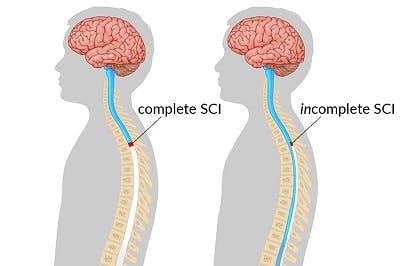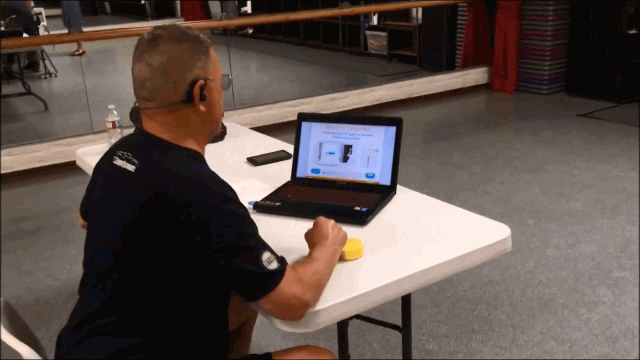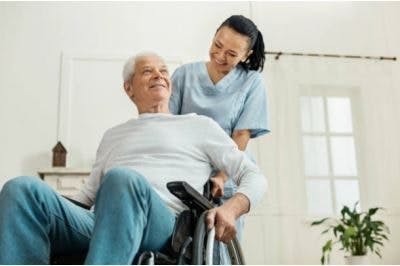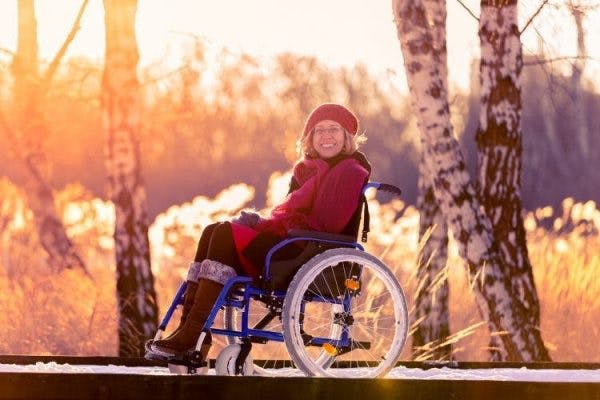Quadriplegia, also known as tetraplegia, describes paralysis of all four limbs. Generally, the trunk is also affected; however, paralysis is typically more severe in the arms and legs. While various functions may be affected by quadriplegia, many individuals learn effective ways to manage their weakness or paralysis and improve their quality of life.
In fact, depending on the cause and severity of quadriplegia, some individuals may be able to recover mobility in their affected muscles.
To help you understand what quadriplegia is, this article will discuss its:
Causes of Quadriplegia
Types of Quadriplegia
Signs and Symptoms of Quadriplegia
Risks Associated with Quadriplegia
Quadriplegia Recovery Outlook
Quadriplegia Treatment
Causes of Quadriplegia
Quadriplegia refers to paralysis of the arms and legs caused by neurological damage. It can occur following a variety of neurological conditions including spinal cord injury and cerebral palsy.
Most commonly, quadriplegia is associated with high-level spinal cord injuries. It is the result of damage to the cervical region of the spinal cord. The spinal nerves in the cervical region branch into various peripheral nerves that transmit signals between the brain and the upper extremities.
Additionally, because messages to and from the brain cannot pass through spinal cord damage, functions below the level of injury (including in the trunk and legs) are also affected. As a result, individuals with quadriplegia due to spinal cord injury experience weakness or paralysis, as well as changes in sensation, in the arms, trunk, and legs.
Common causes of quadriplegia include:
- Motor vehicle accidents
- Falls
- Contact sports
- Gunshot wounds
- Acts of violence
- Stroke in the brainstem
- Lack of oxygen in the brain
- Infection in the central nervous system
- Traumatic brain injury
- Cerebral palsy
- Spinal cord injury
- Multiple sclerosis
- Amyotrophic lateral sclerosis
- Guillain-Barré syndrome
- Transverse myelitis
The following section will discuss various types of quadriplegia associated with different neurological conditions.
Types of Quadriplegia
Depending on the severity of a neurological injury, individuals may experience varying types of quadriplegia.
After a spinal cord injury, individuals may experience:

- Incomplete quadriplegia results from a spinal cord lesion that partially transects the spinal cord. Consequently, some neural pathways that connect the brain to areas below the level of injury are left unaffected by injury. This type of quadriplegia results in varying amounts of preserved function below the level of injury. As a result, individuals with incomplete spinal cord injuries may be able to feel sensation and/or control movements in some areas below their level of injury.
- Complete quadriplegia results from a spinal cord lesion that completely transects the spinal cord. In other words, all neural pathways at the level of injury are affected and messages are unable to be communicated between the brain and the areas below the level of injury. Individuals with complete quadriplegia experience complete loss of motor control and sensation below their level of injury.
Additionally, quadriplegia can result from damage to the brain. Individuals with cerebral palsy (CP) may experience quadriplegia in the form of:
- Spastic quadriplegia is a type of CP caused by damage to the motor cortex. Individuals with spastic quadriplegia experience spasticity (high muscle tone) in their arms, trunk, and legs. It can even affect the muscles in the face and impact an individual’s ability to eat and speak. However, spasticity is most severe in the arms and legs. This typically results in stiff movements through the entire body.
- Ataxic cerebral palsy is a type of CP caused by damage to the cerebellum. As a result, individuals with this type of quadriplegia typically experience poor coordination and balance as well as low muscle tone throughout their entire bodies.
- Dyskinetic cerebral palsy is a type of CP caused by damage to the basal ganglia and/or thalamus. Individuals with this type of quadriplegia experience fluctuations of high and low muscle tone throughout their entire bodies. As a result, they may seem as if they are constantly moving; however, these movements are uncontrollable.
Now that you understand the various ways quadriplegia caused by neurological injury can present itself, let’s discuss how it may affect an individual’s day-to-day life.
Signs and Symptoms of Quadriplegia
Paralysis in the arms, torso, and legs can impact your everyday life in a variety of ways. Depending on the severity of the neurological injury, individuals may experience a wide range of secondary complications associated with quadriplegia.
Signs and symptoms of quadriplegia include:
- weakness or paralysis
- loss of sensation
- bowel and bladder dysfunction
- sexual dysfunction
- breathing difficulties
- poor trunk control (which may influence posture and balance)
- pain, numbness, or tingling below the level of injury
- spasticity (involuntary muscle contractions)
Because quadriplegia affects the majority of the body, individuals may require the help of a caregiver to perform everyday activities such as grooming and feeding.
Additionally, many individuals with quadriplegia need assistive mobility devices such as wheelchairs to increase mobility. Those with more severe weakness or paralysis may find a power wheelchair more helpful while those with milder motor impairments may be able to utilize a manual wheelchair.
The following section will address complications that individuals with quadriplegia have an increased risk of experiencing.
Risks Associated with Quadriplegia
Often, individuals with quadriplegia have an increased risk for additional complications due to their limited mobility.
Risks associated with quadriplegia include:
- the development of pressure sores
- weight gain
- muscle atrophy
- poor circulation
- swelling of the arms and legs
- cold hands and feet
- respiratory complications
- osteoporosis
- autonomic dysreflexia
- social isolation
- depression
Many of these risks are associated with a lack of physical activity. Therefore, it is important for individuals with quadriplegia to work with their caregivers to ensure they are moving around throughout the day. Even light exercise or stretching can help prevent the progression of these complications and promote better functioning of the body.

Home exercise programs like FitMi home therapy can help motivate individuals to be more active and practice movement throughout the day. If the individual has severe weakness or paralysis, their caregiver can move their body through the exercises for them. While the individual may not be actively performing the exercises, the movement will still be able to promote circulation and stimulate the spinal cord.
Up next, we’ll discuss whether it is possible to recover from quadriplegia.
Quadriplegia Recovery Outlook
Damaged neurons in the brain and spinal cord are unable to regenerate. However, areas of the central nervous system unaffected by injury have the ability to recover affected functions by utilizing neuroplasticity.
Neuroplasticity is the central nervous system’s ability to make adaptive changes to its neural circuitry based on the behaviors we repetitively practice. Therefore, the more you practice a function weakened by injury, the more you stimulate the central nervous system and reinforce demand for those functions. This encourages the brain and/or spinal cord to rewire functions affected by injury to unaffected regions and strengthen them.
Generally, the milder your injury, the better the recovery outlook. However, as long as individuals have spared neural pathways, there is potential to recover or at least improve functions affected by quadriplegia.
Although those with complete spinal cord injuries resulting in quadriplegia are unable to utilize neuroplasticity to improve their motor and sensory functions, they can still learn various adaptive techniques to become as independent as possible. The following section will discuss various treatment interventions that utilize neuroplasticity to help individuals with quadriplegia improve their mobility and functional independence.
Quadriplegia Treatment
Treatment for quadriplegia may consist of a variety of interventions. Furthermore, depending on the cause and severity of an individual’s quadriplegia, various treatments may be recommended. Generally, a combination of multiple interventions provides the most effective results.
Below, we’ll discuss some of the most effective ways to address quadriplegia.
Physical Therapy
Physical therapy for quadriplegia focuses on helping individuals strengthen weakened or underused muscles and maintain full range of motion through targeted exercises. A physical therapist will teach individuals the most effective exercises to stimulate neuroplasticity in the central nervous system.
A physical therapist may also recommend orthotics such as braces and splints to promote correct musculoskeletal alignment and assist with mobility.
Occupational Therapy

Occupational therapy for quadriplegia focuses on helping individuals become as functional as possible, primarily through activities of daily living. An occupational therapist will work with individuals with quadriplegia and their caregivers to teach them the most effective ways to perform everyday activities such as transferring, bathing, and grooming.
This may involve learning how to use adaptive tools, such as a universal cuff, or adaptive techniques like tenodesis. Tenodesis is a natural movement that all of our bodies make. When you bend your wrist forward, the hand should open up. Likewise, when you extend the wrist (bend it backward), the fingers should curl in. Learning to utilize a tenodesis grasp can help individuals with quadriplegia become more independent.
Speech Therapy
Individuals with quadriplegia often experience oral motor impairments that affect their ability to chew, swallow, and speak. Additionally, individuals with spinal cord injuries at the C5 level or above may experience breathing difficulties due to impaired innervation of the diaphragm. A speech therapist can help individuals with quadriplegia improve their oral motor functions, communication skills, and breathing.
Home Programs
While participation in rehabilitative therapies is an excellent way to promote recovery and increase independence, continuing to practice skills learned in therapy at home is essential to optimize your results. Many therapists will provide you with a list of exercises or activities that you can work on daily at home to continue making improvements even outside of therapy sessions. Your therapist may also encourage your caregiver to accompany you to your therapy sessions occasionally so he or she can learn the best techniques to use with you at home.
Psychotherapy
Individuals with quadriplegia may develop mental health problems such as depression or anxiety due to feelings of isolation, lack of support, or difficulties adjusting to life with paralysis. Working with a psychotherapist can help individuals with quadriplegia better understand their negative feelings and find more effective ways to cope.
Medications
Individuals with incomplete quadriplegia or quadriplegia that results from damage to the brain often experience involuntary muscle contractions known as spasticity. Spasticity can significantly restrict movement and affect an individual’s ability to participate in physical and occupational therapy.
To reduce spasticity, therapists may recommend Botox injections or muscle relaxants to temporarily relieve high muscle tone. This creates a window of opportunity for individuals to practice therapeutic activities and exercises without the interference of spasticity. Often, some of the improvements made while spasticity is controlled are maintained even after the effects of the medication wear off due to neuroplasticity.
Surgery
Individuals with severe spasticity after spinal cord injury that do not respond to other forms of treatment may benefit from surgery. However, the surgery will differ based on the individual. For example, surgery for spasticity may involve manually lengthening of the muscles and tendons, the implantation of an intrathecal baclofen pump, or selective incisions of nerves that cause hyperactive muscle contractions.
Support
Individuals with quadriplegia may struggle to feel accepted, supported, or understood. Friends and family may benefit from educating themselves about their loved one’s condition and being mindful about what to expect or potential complications that may arise. Often, just being there to spend quality time with your loved one and listening to them can make a huge difference.
Another helpful way for individuals with quadriplegia to find support is to join a support group. There, they can speak to others who are also going through a similar journey.
Quadriplegia: Final Thoughts
Quadriplegia describes paralysis of the arms, trunk, and legs resulting from damage to the brain and/or spinal cord. Despite affecting so many muscles in the body, many individuals with quadriplegia learn to effectively manage their paralysis. Some even learn to improve their mobility by promoting neuroplasticity through repetitive, task-specific practice.
We hope this article helped you understand what quadriplegia is and how to manage it.











